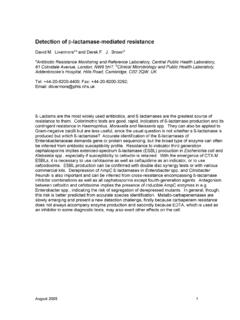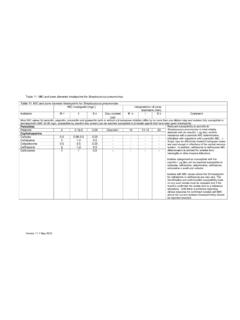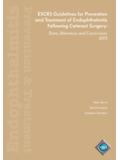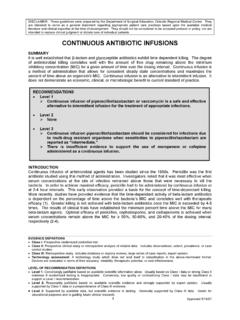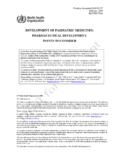Transcription of Establishing MIC breakpoints and the interpretation of in ...
1 Updated 2005 January 2005 1 Establishing MIC breakpoints and the interpretation of in vitro susceptibility tests Alasdair P. MacGowana* and Richard Wiseb aDepartment of Medical Microbiology, North Bristol NHS Trust, Southmead Hospital, Westbury-on-Trym, Bristol BS10 5NB; bDepartment of Microbiology, City Hospital NHS Trust, Birmingham B18 7QH, UK Corresponding author: Tel: 0117 959 5652; Fax: 0117 959 3154; Email: The purpose of undertaking susceptibility testing, by whatever method, is to attempt to integrate the drug potency against a population of potential pathogens with the pharmacokinetics of the antimicrobial and, whenever possible, to review this relationship in the light of clinical experience following therapy in clinical trials.
2 breakpoints are discriminatory antimicrobial concentrations used in the interpretation of results of susceptibility testing to define isolates as susceptible, intermediate or resistant. Clinical, pharmacological, microbiological and pharmacodynamic considerations are important in setting breakpoints . The ideal mix of these factors is under constant discussion. Different countries have different approaches to this problem but, by and large, their approaches have much in common which has allowed for the recent progress in setting European breakpoints through the European Committee on Antimicrobial Susceptibility Testing (EUCAST). This paper attempts to summarize the philosophy of the British Society for Antimicrobial Chemotherapy (BSAC) Working Party in conjunction with EUCAST in its approach to setting breakpoints and to update the activities of the Working Party since it initially published breakpoints .
3 The formula outlined by the BSAC Working Party in 1991 has again been used to set the breakpoints presented here. However, in future, BSAC clinical breakpoints will reflect those set by EUCAST, and this year new breakpoints for fluoroquinolones, aminoglycosides, glycopeptides and linezolid are included. The Working Party accepts that in the light of new knowledge, there is a need to reassess how clinical breakpoints are defined, and this paper also summarizes the future activities of the Working Party with EUCAST/in this important area. Updated 2005 January 2005 2 introduction The need to know whether an organism is likely to respond to antimicrobial therapy is as old as chemotherapy itself, and the background has been covered in this Supplement by A number of mechanisms exist by which one may establish the breakpoint between a susceptible and resistant population of bacteria.
4 In the USA, the Clinical Laboratory Standards Institute (CLSI), formerly NCCLS, publishes such guidance,2 and has significant influence in many parts of the world. Other countries, however, have a different philosophy and different methodological details. Within Europe, there are six active national breakpoint committees, the Comite de l Antibiogramme de la Societe Francaise de Microbiologie (CA-SFM)3, France; German Institute for Standardisation (DIN), Germany; the Norwegian Working Group on Antibiotics (NWGA), Norway; Swedish Reference Group for Antibiotics (SRGA)4, Sweden; the Commissie Richtlijenen Gevoeligneids Depalingen (CRG), The Netherlands; and the BSAC Working Party on Susceptibility Testing, United Kingdom.
5 The activities of these Committees is now co-ordinated through the European Committee on Antimicrobial Susceptibility Testing (EUCAST) which is a standing committee of the European Society for Clinical Microbiology and Infectious Diseases (ECCMID), and part funded by the European Union (EU). All methods used attempt to integrate the pattern of in vitro potency and pharmacodynamics of an antibacterial against a population of bacteria with the pharmacokinetics of the antimicrobial and then, where possible, to review this relationship in the light of clinical experience. All have many problems in common. These include the following: (i) The need for antimicrobial group testing; namely, can one agent be taken as representative of others?
6 Commercially and scientifically this is a thorny problem. (ii) How to take into account the changing dosing regimens (for example, penicillin and ampicillin dosing for pneumococci with intermediate susceptibility). (iii) Infections at specific sites, including the urinary tract, and the possible need for site-specific breakpoints . (iv) The role of the intermediate category between susceptible and resistant populations. (v) How to deal with organism-antimicrobial combinations where a substantial proportion of the distribution of susceptibility straddles the pharmacodynamic breakpoint. It has been said that it would be far simpler to choose one international method of susceptibility testing and breakpoint determination, and the method usually suggested is that of the CLSI.
7 An increasing number of the scientific community believe that there should be a 'European' method. The different methods have both strengths and weaknesses. For example, the CLSI utilizes inocula and media with which the BSAC Working Party and other bodies have fundamental problems. Moreover, the CLSI breakpoints are, in this Working Party's view, not conservative enough, tending to be higher than those of the BSAC. In addition, it now seems clear that breakpoints can be considered in two ways. The first is a value which divides bacteria into those which are likely to respond to antimicrobial chemotherapy and those which do not. The second is a microbiological approach which seeks to identify strains which do not belong to the normal (antibiotic nieve) population.
8 We believe the primary function of in vitro antimicrobial susceptibility testing in clinical laboratories is to provide information to prescribers on the choice of appropriate chemotherapy, whether it be for therapy in specific patients, or to help in antimicrobial policy formulation. Here the use of clinical breakpoints is needed. Increasingly, routine susceptibility testing is also seen as having public health significance, in that the data generated can be used to track the occurrence and prevalence of antimicrobial resistance in the geographical area served by the laboratory. This needs to be supported by identification to a species level in many situations. Here the use of microbiological breakpoints may be best.
9 While the clinician expects the laboratory to provide Updated 2005 January 2005 3 information categorizing isolates as susceptible, intermediate or resistant, such categories are not optimal for epidemiology. The definitions now proposed by EUCAST divide definitions into clinical breakpoints and wild type cut-offs. (a) Clinically resistant A micro-organism is defined as clinically resistant by a level of antimicrobial susceptibility which results in a higher than expected likelihood of therapeutic failure. A micro-organism is categorised as clinically resistant (R) by applying the appropriate breakpoint in a defined phenotypic test system. This breakpoint may be altered with legitimate changes in some circumstances.
10 (b) Clinically susceptible A micro-organism is defined as clinically susceptible by a level of antimicrobial susceptibility which results in an improved, or the desired, therapeutic outcome. A micro-organism is categorised as clinically susceptible (s) by applying the appropriate breakpoint in a defined phenotypic test system. This breakpoint may be altered with legitimate changes in some circumstances. (c) Clinically intermediate A micro-organism is defined as clinically intermediate by a level of antimicrobial susceptibility which results in an indeterminate therapeutic outcome. (d) Wild types and microbiological resistance Microbiological resistance is defined as a reduction in susceptibility from the wild type distribution of susceptibility for a species in a defined phenotypic test system.
